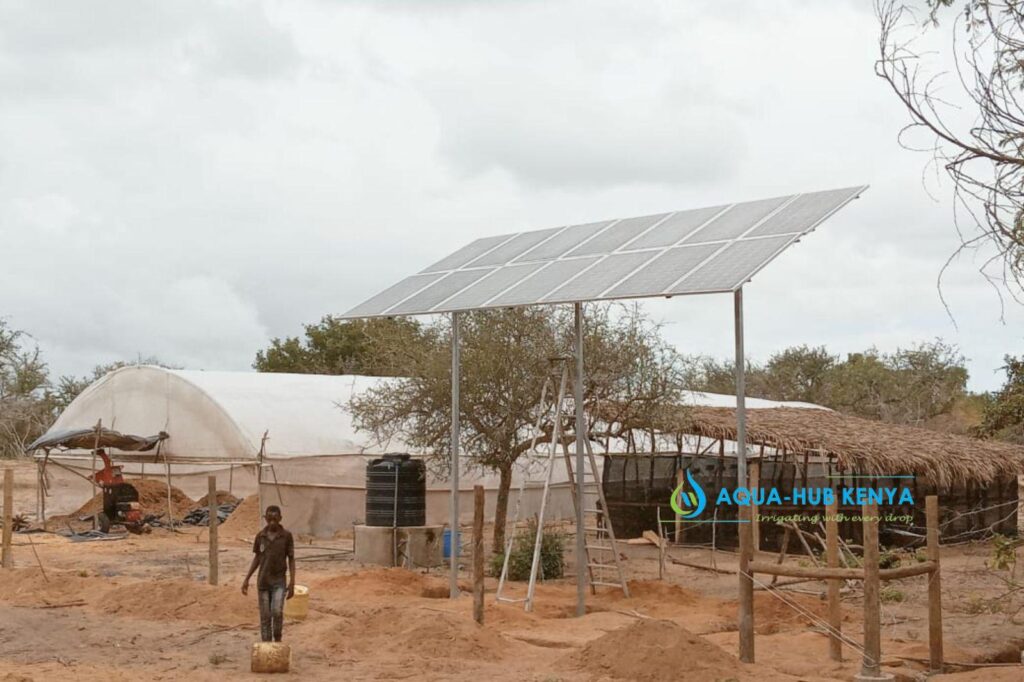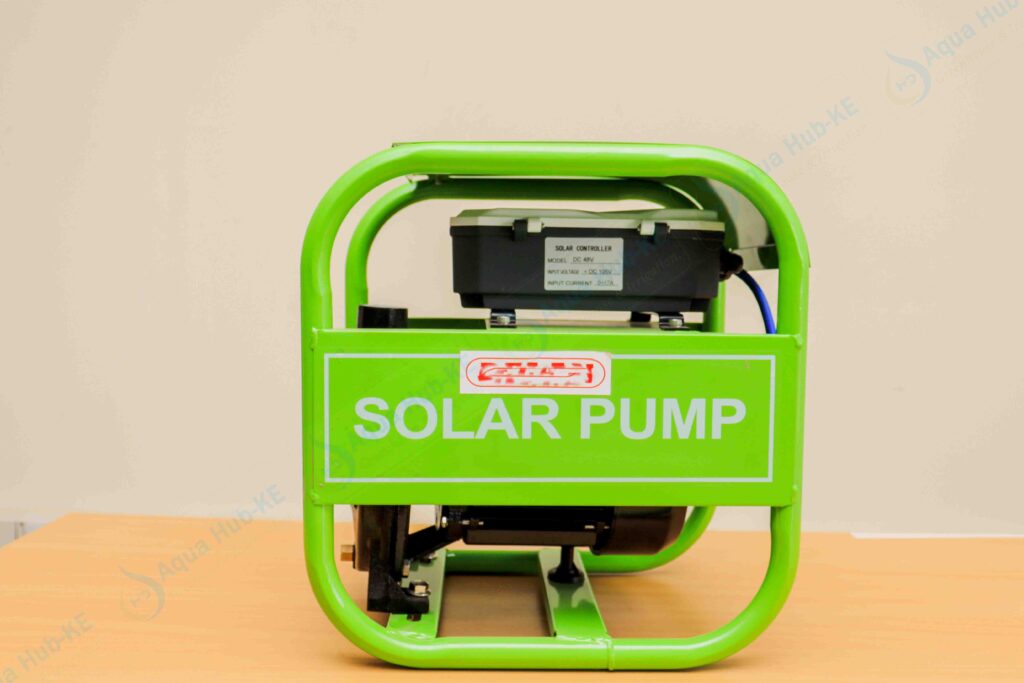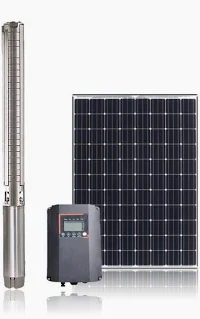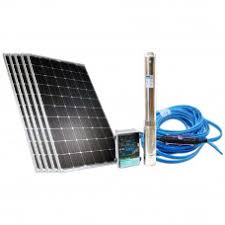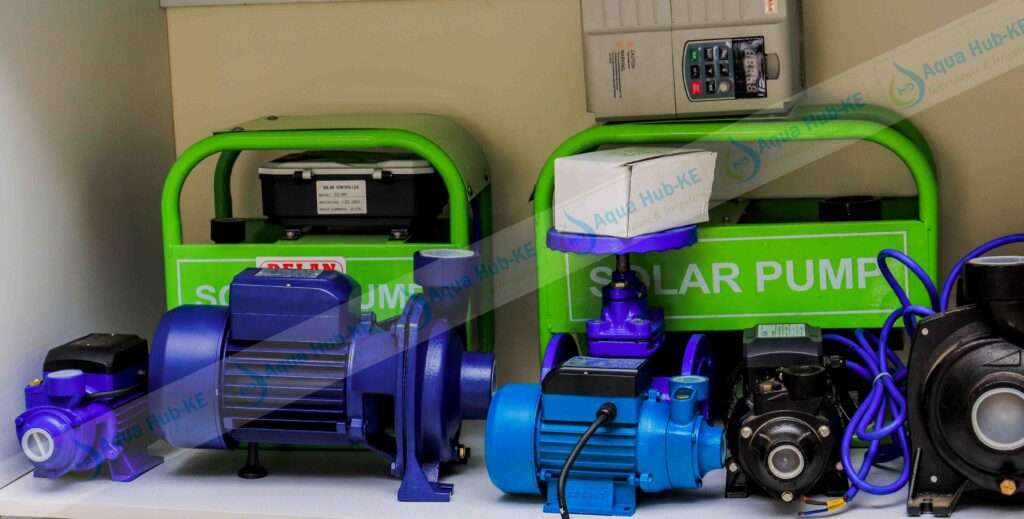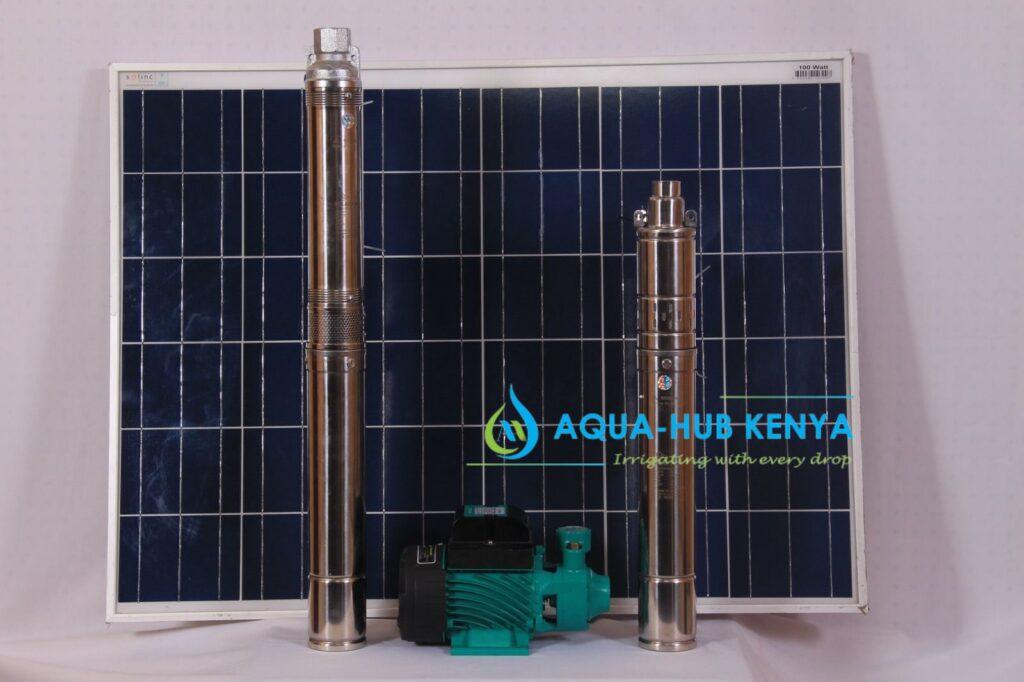Blog
Solar Well Pumps in Kenya

Solar well pumps in Kenya by Aqua Hub Kenya are dependable and low-cost pumps designed for drawing water from deep and shallow wells. Our pumps are ideal for home use, irrigation water supply and industrial water suction.
Why Solar Well Pumps
The campaign for sustainability which includes access to clean water and economic irrigation farming has led to increase in popular use of solar well pumps. Individuals, farm cooperatives and community support organizations are investing in solar pumps because of their cost-effective and environment friendly operation.
Whether for irrigation, livestock watering, or domestic use in remote areas, solar well pumps make a difference by reducing the cost of water supply.
But what exactly goes into a solar well pump system? How much do they cost, and what are the best options available in the Kenyan market? This blog summarizes the requirements, cost, ideal solar pump options, durability, suppliers and maintenance.
Solar Well Pump Price in Kenya
Solar Well Pumps Price in Kenya varies from as low as KES 15,000 to around KES 85,000 for high pressure | flow rates and models.
What Affects Solar Well Pump Price?
- Pump Size – large solar pump with horsepower is expensive
- Power rating – power rating affects the price. For example, a 200W, 24 V pump cost lower than a 2200W pump.
- Brand – Popular brands in the world are highly reliable and thus more expensive than local brands.
- Pump type – expect submersible well pump to cost more than surface pumps because of their complex design.
- Pump system requirements (Components) – the cost of solar pump requirements including solar pumps will add onto the package.
- Installation: depth of well, and pump head will affect the cost.
Are Solar Well Pumps Worth Investment?
It is important to overlook the aftermath of investing in the solar pump rather than the initial cost which could be higher when buying a solar pump. Solar well pumps have zero running costs; they don’t need fuel or electricity. They are therefore cheaper alternatives with long lifespan gives value for money especially for irrigation farmers in rural or off-grid areas.
Solar Pumps for Sale in Kenya

The demand for Aqua Hub’s sustainable water Pumps in Kenya is growing. We specialize in quality and top-rated water pump brands in Kenya. To buy a reliable water pump for your well, consider reaching out to our team for advice.
Call 0790719020
What Should I ask When Buying a Water Pump?
Important things to inquire are warranties, installation, sizing, spare parts, operation and pump maintenance. At Aqua Hub LTD we offer professional training, and installation of your water pumps. We sell brand new warranted water pumps.
Types of Solar Well Pumps in Kenya
Submersible Solar Well Pump: solar pumps designed for narrow wells and boreholes. Operates while fully immersed in water, lifting water for maximum of 300m head.
Surface Solar Well Pumps: installed on the ground surface for pumping water from shallow wells or pools.
DC Solar Pumps: types of well pumps that operate on direct current from solar panels. They are highly efficient and are ideal for small to medium-sized applications.
AC Solar pump: Requires an inverter to convert Direct current to Alternating current which powers the pump. Ideal for large scale pumping needs with high power consumption.
Choosing the right type depends on the depth of your water source, the volume of water you need, and your budget.
Top Brands of Solar Well Pumps in Kenya: Quality and Performance
- Grundfos: A popular pump brand known for high quality and efficient solar pumping systems.
- Davis & Shirtliff: Reliable Pump Supplier in Africa with wide range of pumps. They have different models of solar pumps for efficient water supply.
- R.I: Manufactures high performance irrigation and water supply solar pumps.
- AICO: offers submersible, and centrifugal pumps.
- Pedrollo: also offers reliable models of submersible and solar pumps in Kenya
- Jiandong (JD): known for top performance solar pumps.
What to Consider for a Reliable Solar Well Pump
- Power Rating (Watts/HP): Indicates the energy required to operate the pump.
- Maximum Head (Meters): The maximum vertical height the pump can lift water. This is crucial for deep wells.
- Flow Rate (Liters per Hour/Cubic Meters per Hour): The amount of water the pump can move per unit of time. This should align with your daily water demand.
- Outlet Size (Inches): The diameter of the pump’s outlet, which influences the flow rate.
- Voltage (V): Whether the pump operates on DC or AC, and its specific voltage requirements.
- Material: Durable, non-corrosive materials like stainless steel are essential for longevity, especially for submersible pumps.
Requirements to Run a Solar Pump
- Solar Panels/PV Modules – Key devices that harvest solar energy and convert it to DC electric current. The number and wattage of panels depend on the pump’s power requirements and daily sunlight hours.
- Solar well Pump: Actual water conveyance device.
- Solar Inverter: Converts DC current to AC electric current for use by AC pumps.
- Pump Controller: Regulates DC current in DC Solar Pumps to prevent damage.
- Electric cable and circuit connections: for electric transmission. Includes DC and AC breakers.
- Mounting Structures: solar panels need to be kept in raised areas where they can access sunlight. Strong steel structures are ideal for holding the solar panels.
- Pipes and Fittings: To transport water from the pump to the point of use or storage.
- Check Valve: prevents backflow of water.
- Backup battery Cells (optional): you may need to battery cells in the system to store solar power for use in case sunlight is unavailable.
- Water Storage Tank: depending on the water needs, whether irrigation or home use, you may need to setup a tank to store water drawn from your well.
- Backup Batteries (Optional): Some systems integrate batteries to provide water during non-sunny hours, though this adds to the cost and complexity. Most basic solar well pump systems operate directly from solar power.
How Many Solar Panels to Run a Well Pump?
It depends on power rating of solar well pumps and the power loss in the system.
An approach to calculate the number of solar panels required is as follows;
- Convert Pump HP to Watts/kW: If your pump is rated in HP, convert it to kilowatts (1 HP ≈ 0.746 kW). Then convert kW to Watts (multiply by 1000).
- Example: A 1 HP pump is approximately 0.746 kW or 746 Watts.
- Account for System Losses: Solar pumping systems experience power losses during transmission and conversion. A common multiplier to account for these losses is 1.25 for monocrystalline panels and 1.5 for polycrystalline panels.
- Example (using 1.5 for simplicity): For a 746-Watt pump, you’d need approximately 746 W * 1.5 = 1119 Watts of solar panel capacity.
- Calculate Number of Panels: Divide the total required solar panel wattage by the wattage of a single solar panel.
- Example: If you need 1119 Watts and you’re using 350-Watt solar panels, you will need 1119 / 350 ≈ 3.2 panels. In this case, you would round up to 4 panels to ensure sufficient power, especially during low sunlight conditions.
Things to Consider When Sizing Solar Well Pumps
- The number of full sunlight hours: Sunlight hours may vary depending on location or seasons.
- Volume of water required: sizing is done according to the water requirements.
- Efficient sizing: sizing should be done by a professional pump technician to ensure accuracy and pump safety.
Ideal Solar Pumps for Wells in Kenya
Submersible solar well pumps are the reliable options for deep wells. Here’s why:
- Efficiency at Depth: Submersible pumps are designed to operate underwater, effectively pushing water from great depths to the surface. Surface pumps have a limited suction lift and are not suitable for deep wells.
- Less Noise: Being submerged, the pump’s operation is significantly quieter, as the surrounding water dampens vibrations and sounds.
- No Priming Issues: Unlike surface pumps that can lose prime (where air gets trapped), submersible water pumps are always surrounded by water, ensuring continuous and smooth operation.
- Better Cooling: The water around the pump acts as a natural coolant, preventing overheating, which can be a common issue for surface pumps.
- Durability: Made with robust, non-corrosive materials, they are built to withstand the harsh conditions of being submerged.
For shallow wells or surface water sources like rivers or dams, a surface solar pump can be a cost-effective and easy-to-maintain alternative.
How Far do Solar Well Pumps Push Water
Solar well pumps in Kenya are designed push water from 25 meters for smaller types to over 250 meters for robust borehole pumps. For example, a 1500W, 110V pump might have a maximum head of 135m, while a 2200W, 300V pump could reach 255m.
Lifespan of Solar Well Pumps in Kenya
Solar pumps and the entire system components have a long-lasting performance. Durability is affected by installation, pump brands and maintenance. Solar panels last for upto 25 years while solar water pumps and controllers can last for 5 to 10 years.
How to Ensure Long term Performance of Solar Pumps & Components
- Professional installation and sizing of solar pumps ensures correct sizing and connection.
- Regular cleaning of solar panels: to remove dust which may affect solar power harnessing
- Inspection of solar pumps and system components: to check damaged or faulty cables. Monitor pump noise as well.
- Proper solar panel and inverter location: ensure the inverter, solar panels and controller are installed in a secure area. The controller and inverter should be kept away from rain, sunlight and dust.
- Preventative Maintenance: Address minor issues before they escalate. This might include checking filters, connections, and alignment.

